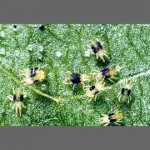I definitely noticed phytotoxicity while using Imid. The more Imid I used the more sensitive my plants became, and it never completely stopped the RA's. It just seemed to slow them down and further deteriorate plant health.
Same here regarding the toxicity. As a preventative, now that my garden is free of the aphids, i have started using weak solutions of imid as a preventative. The stress has been lessened using the weak solution, however, its still there.




